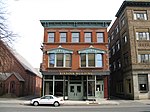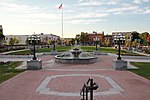United States Whip Company Complex
Historic district contributing properties in MassachusettsIndustrial buildings and structures on the National Register of Historic Places in MassachusettsNRHP infobox with nocatNational Register of Historic Places in Hampden County, MassachusettsUse mdy dates from August 2023 ... and 1 more
Westfield, Massachusetts

The United States Whip Company Complex or "United States Line Company Complex" is a historic factory located in Westfield, Massachusetts. It was owned and operated by one of the whip-making businesses that led Westfield to become widely known as "Whip City". United States Whip, created in 1892 by the consolidation of several local manufacturers, was the world's largest manufacturer of whips. The factory complex was listed individually on the National Register of Historic Places in 1983, and as part of an expanded Westfield Center Historic District in 2013.
Excerpt from the Wikipedia article United States Whip Company Complex (License: CC BY-SA 3.0, Authors, Images).United States Whip Company Complex
Broad Street, Westfield
Geographical coordinates (GPS) Address Nearby Places Show on map
Geographical coordinates (GPS)
| Latitude | Longitude |
|---|---|
| N 42.12 ° | E -72.748055555556 ° |
Address
First Congregational Church of Westfield
Broad Street 18
01085 Westfield
Massachusetts, United States
Open on Google Maps











